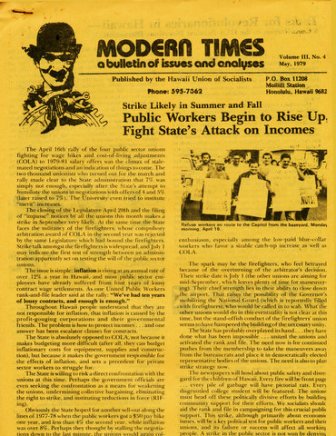
First Published: Modern Times, Vol. III, No. 4, May 1979.
Transcription, Editing and Markup: Paul Saba
Copyright: This work is in the Public Domain under the Creative Commons Common Deed. You can freely copy, distribute and display this work; as well as make derivative and commercial works. Please credit the Encyclopedia of Anti-Revisionism On-Line as your source, include the url to this work, and note any of the transcribers, editors & proofreaders above.
The coalition of Hawaii public sector unions combatting the State’s intransigent opposition to cost of living adjustments to worker’s incomes marks an important step forward in the recent history of the labor movement in Hawaii. However, socialists will be hard pressed to advance this struggle beyond reformist trade unionism unless we develop an overall analysis of capitalism’s situation in Hawaii today.
Hawaii has a long history of labor militancy, including in particular the initial organizing of the plantation work force into the ILWU with the assistance of the Communist Party and allied militants. But these historic struggles have been successfully channeled into reformist directions over the last twenty years, with the virtual integration of the unions with the Democratic Party. Struggles which now exist—such as Kalama Valley in the early 70’s, or Chinatown today—are scattered across the political landscape, with little unified and coherent inter-relationship with long-term goals for social justice through socialist revolution. Although workers and oppressed nationalities in Hawaii remain combative, the left has not been able to provide coherent leadership to these struggles in terms of challenging the power of capitalism in Hawaii, a capitalism which is daily changing under the pressure of international corporate adventures.
Hawaii is witnessing the demise of its agricultural proletariat and its replacement with a much more dispersed and atomized service sector working class based on the tourism industry. In many ways Hawaii is becoming re-colonized with new political contradictions arising between the local bourgeoisie (“Palaka Power,” for example) and the agents of the multinational corporations which increasingly control Hawaii’s destiny. Hawaii’s unions are increasingly tied by their bureaucratic leaders to the success of the capitalist system, and the struggles for Hawaiian rights, women’s liberation, low-cost housing, and environmental protection are contrasted to the need for jobs and incomes.
Hawaii is increasingly tied to business conditions on the Mainland and Japan, so that the general economic stagnation which has affected the capitalist world since 1968 will make this tourism-based economy even more fragile. Yet the social needs brought about by the shifting structure of Hawaii’s economy and the fundamental weakness of tourism as a viable economic institution raise the serious question in the minds of people throughout Hawaii . . . where lies the future? Or, “what the fuck, they goin’ broke this island?” The weight of that pressure can be seen by the appeal of the Kahoolawe Ohana, Hale Mohalu, and nowhere more than by the pressure of the public workers rank and file for a cost of living allowance in the current negotiations. The failure of the Governor and the Legislature (including the absurd posturings of Cayetano) to respond in even a minimal way to these demands severely hinders the sell-out hopes of the Trasks and Epsteins, but also makes it necessary for revolutionaries to provide a coherent political alternative to liberal capitalism. Failure to do so will mean a temporary solution to the capitalists’ needs to reorient and depoliticize Hawaii’s working class, reducing social services and slashing real incomes.
HUS (and the socialist movement in general) needs to develop an action program to link today’s many struggles to the needs of the future, to develop forms of mass organization with union members which will show the way for real workers’ democracy, and to strive to break Hawaii’s political isolation from outside political movements. The May Day program, although generally successful, mobilized few workers and showed how weak our present ties are with workers.
The dangers of a 15% decline in incomes through inflation over the next two years, followed by the spectre of high unemployment with recession in 1980, possible restrictions on gasoline fuel purchases, and continued State fiscal austerity (including the imminent lay-off of over 1,400 CETA workers this fall), make revolutionary socialist tasks seem incredible.
Yet we have the experience of several years of struggle and the creativity of the masses at our fingertips, if we are committed enough to make that step. A central political initiative and program posing the elementary needs of the working class in Hawaii and including and uniting the existing social struggles could provide a powerful socialist alternative to challenge the monopoly of political representation now held by the bourgeoisie. This is, indeed, the only way forward for the working people of Hawaii.